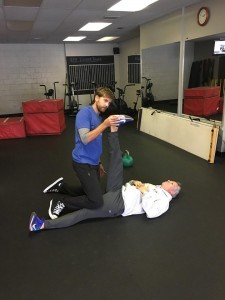Finding the Gaps in Your Training
In training there are similar balances that exist. We need a certain amount of sympathetic stress (fight or flight) to get things done and keep us alive. And this needs to be paired with times of parasympathetic stress (rest and digest) when we can recover and relax. We need just the right amount of mobility coupled with an appropriate amount of stability to control the movement. Too much of either is not advantageous.
We could list many more examples related to our health and the body where optimal health exists in a range between the two. Below are two specific examples you can test yourself to determine how to adapt your training going forward.
These two examples can thought of as gaps. Or maybe differentials might be a better term than gaps. I'm using the term gap as this is how one of the examples was explained to me by Dr. John Rusin. He referred to something called the motor control gap and defined this as passive range of motion minus active range of motion. Writing this out as a mathematical equation this becomes:
motor control gap = passive ROM - active ROM
Passive range of motion refers to the extent a joint can be moved by an external force with no effort by the individual. For example, in the picture below we are assessing the passive range of motion as the leg is being lifted for me into flexion with no effort on my part.
[caption id="attachment_5278" align="aligncenter" width="225"] Passive range of motion
With active range of motion there is no external assistance to move the joint through a range of motion.
[caption id="attachment_5276" align="aligncenter" width="225"]
 Active range of motion
Active range of motionIn both cases the end range of motion is a comfortable end point and is not being pushed past tolerable limits.
What we are looking for here is a difference, and the magnitude of the difference, between passive and active range of motion i.e. motor control gap. The smaller the motor control gap the better. A larger motor control gap tends to be associated with higher rates of injury and decrements in athletic performance.
The other gap to discuss here is the difference of what we can press overhead with a kettle bell. This idea was first proposed to me by Max Shank at the Okanagan Strength & Conditioning Conference a few years ago.
Sometimes we can chase strength as the solution to all of our problems. Didn't do well in your athletic event? Get stronger. Got injured? Get stronger. Want to look better on your beach vacation? Get stronger.
Strength can almost appear to be the Windex of fitness training.
[caption id="attachment_5266" align="aligncenter" width="274"]
 Just like Windex won't fix everything, more strength isn't always the answer either.
Just like Windex won't fix everything, more strength isn't always the answer either.The gap Max was referring to was the difference between what you can press overhead with a kettlebell in a normal racked position and what you can press overhead with the KB in a bell up position.
For example, there are a number of strong guy who might be able to press a 36-48 kg KB overhead. This conversation came up in the gym the other day with Graeme asking someone to press 'the beast', or the 48 kg bell overhead. The answer to this challenge was 'easy'.
And while a number of guys might be able to press up to 48 kg overhead a number of them would struggle with pressing half that weight, or 24 kg, overhead in the bell up position.
What should we look for in terms of a gap? Again similar to the motor control gap described above, the smaller the gap the better. A big gap may be an indicator of future injury or performance leaks.
There are a few other things to mention with the overhead press. This test is all relative to the weight that can be pressed overhead. If someone is weak as a kitten and can only press the 4 kg bell overhead and can do the same with the bell up they need to get stronger overall before the test tells too much. Hand size also matters with this test as grip strength is often times proportional to the size of ones hands. And lastly, pay attention to the gap on the left and right sides of the body. Is the gap the same on your dominant versus non-dominant limb?
Test yourself to determine how you stack up in terms of your motor control gaps. Use pictures or videos, as I did above, to compare the difference. And with the bell up press find out how big of a gap there is and if you vary from left-right. Addressing these gaps will minimize the potential for injury and help you address your weak links.
If you'd like some helps to assess your 'gaps' give us a call at (250) 212-2972. We'd be happy to assess your training and health plan to make sure you are on the right path.
When you subscribe to the blog, we will send you an e-mail when there are new updates on the site so you wouldn't miss them.

Comments